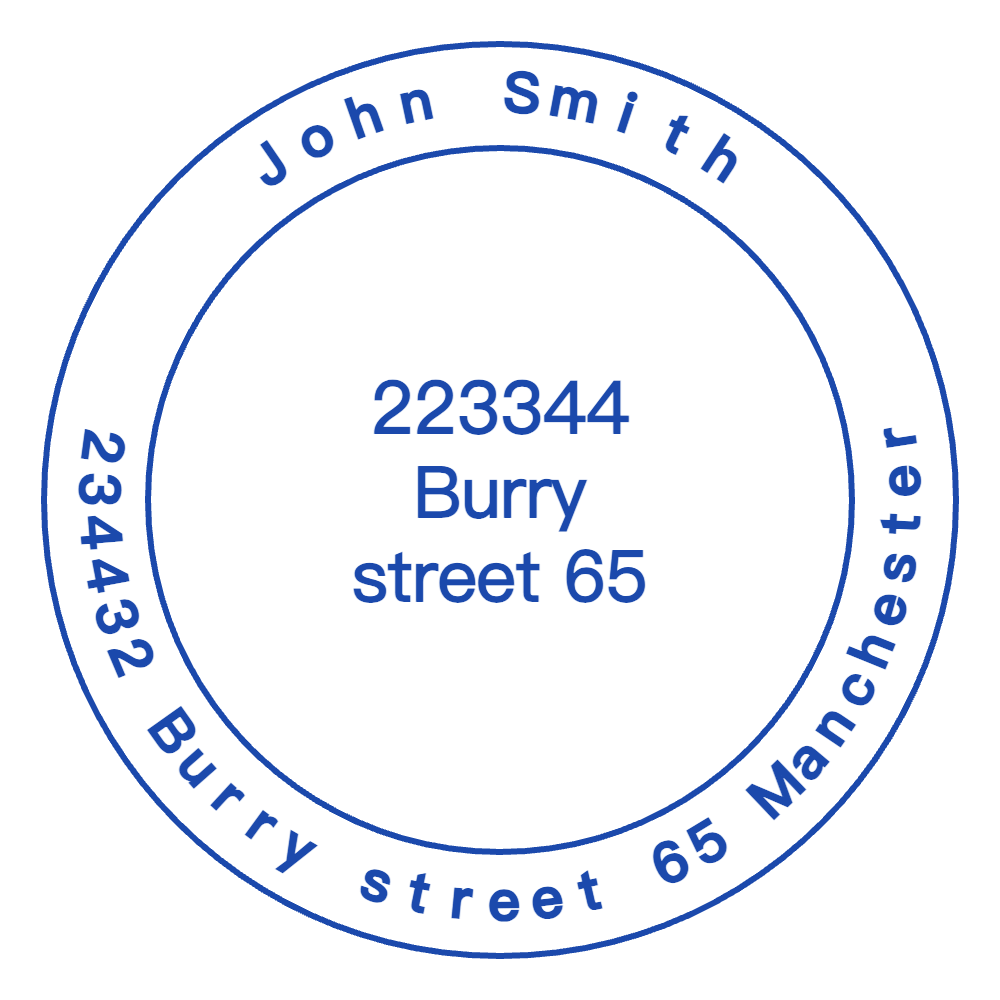Address Stamp Templates
Free editable address stamp templates for online editing
Found 6 address stamp Templates






Everything You Need to Know About Address Stamps: A Complete Guide
Writing your address repeatedly on envelopes, packages, or documents is tedious, inconsistent, and time-consuming. An address stamp solves this problem by delivering clear, uniform impressions in seconds—whether for personal mail, business correspondence, or event planning. At Stampdy, our address stamp templates are designed to fit every need, from simple personal use to professional branding. This guide breaks down the essentials of address stamps: types, uses, selection tips, and how to get the most out of your stamp.
What Is an Address Stamp?
An address stamp is a tool that imprints your name, address, and optional details (like contact info or logos) onto surfaces like paper, envelopes, or packages. Unlike handwritten addresses, it eliminates legibility issues, speeds up mailing tasks, and adds a polished touch.
For example:
- A small business owner can stamp invoices with their company address and logo in seconds, cutting down on administrative time.
- A homeowner can personalize holiday cards with a family name stamp—no messy handwriting or inconsistent spacing.
- A wedding planner can use a custom address stamp to mark save-the-dates, ensuring every envelope looks cohesive.
The core value of an address stamp lies in its efficiency: it turns a 30-second task (writing an address) into a 2-second one, saving hours over weeks or months. It also reduces the risk of misdeliveries caused by unreadable handwriting—a critical benefit for businesses sending customer orders or individuals mailing important documents.
Key Types of Address Stamps (and Who They’re For)
Not all address stamps work for every situation. Our address stamp templates include four main types, each designed for specific use cases:
1. Personal Address Stamps
Personal stamps are built for individual or family use, focusing on simplicity and personality. They typically include:
- Full name or family name (e.g., “The Carter Family”)
- Residential address (street, city, state, ZIP code)
- Optional extras: small graphics (flowers, monograms, holiday themes) or a phone number (for house guests to reference).
Who it’s for:
Homeowners, renters, frequent mail senders (e.g., holiday cards, birthday invitations), or anyone organizing personal items (like notebooks or storage boxes). A personal stamp with a seasonal graphic (e.g., a pumpkin for fall mail or a snowflake for winter) adds a fun, unique touch to everyday correspondence.
2. Business Address Stamps
Business stamps prioritize professionalism and branding. They go beyond basic addresses to include:
- Company name (prominently displayed)
- Business address (physical location or PO box)
- Contact details (phone number, email, website)
- Optional logo or tagline (e.g., “Serving Denver Since 2018”).
Who it’s for:
Freelancers (writers, graphic designers), small business owners (cafés, boutiques, Etsy shops), or office managers handling bulk mail (invoices, customer updates). A business stamp turns ordinary envelopes into subtle marketing tools—every piece of mail reinforces your brand identity.
If you want to design a business address stamp with a custom logo or layout, our online stamp design maker can help you create a polished, professional look without any design experience.
3. Self-Inking Address Stamps
Self-inking stamps are the most convenient option for frequent use. They have a built-in ink pad that automatically recharges the stamp after each impression, so you don’t need to carry a separate pad or worry about messy reinking.
Most self-inking stamps make 5,000+ impressions before needing an ink refill—perfect for high-volume tasks like mailing monthly invoices or event invitations.
Who it’s for:
Small business owners sending 50+ pieces of mail weekly, event planners (weddings, conferences), or administrative staff. If you’re new to creating this type of stamp, our stamp maker online guide walks you through the process of customizing and ordering a self-inking address stamp.
4. Pre-Inked Address Stamps
Pre-inked stamps use oil-based ink embedded directly into the stamp surface, producing crisp, smudge-free impressions—even on glossy paper (e.g., wedding invitations) or plastic packaging. They’re more compact than self-inking stamps, making them easy to carry in a bag or desk drawer.
Who it’s for:
Wedding planners, photographers (marking client packages), or real estate agents (stamping documents on-site). Their precision and portability make them ideal for situations where a professional finish matters. For a step-by-step guide to creating a pre-inked address stamp, check out our create a stamp online tutorial.
How to Choose the Right Address Stamp
With so many options, selecting the best address stamp depends on three key factors:
1. Define Your Use Case
Start by asking: Will this stamp be for personal or professional use?
- Personal use: Opt for a small-to-medium stamp with a fun graphic (e.g., a dog for a pet lover) or family name. Avoid overcomplicating it—keep the design simple and easy to read.
- Business use: Choose a medium-to-large stamp with your logo and contact info. Avoid overcrowding—stick to 1–2 key details (e.g., company name + website) to keep impressions legible.
If you’re unsure about the design, our stamp maker online free tool lets you test different layouts and graphics before committing to a purchase.
2. Pick the Right Size
Size matters—too small, and the address will be unreadable; too large, and it won’t fit on standard envelopes. Common sizes for address stamps:
- Small (1.5” x 0.5”): Ideal for postcards, gift tags, or wedding save-the-dates.
- Medium (2” x 1”): The most versatile size—works for standard envelopes (No. 10, the size used for bills and letters), notebooks, or small packages.
- Large (3” x 1.5”): Best for large envelopes or boxes where visibility is key (e.g., shipping products to customers).
3. Choose Durable Materials
The material of your stamp affects its lifespan and the quality of impressions. At Stampdy, we use two main materials for address stamps:
- Rubber: Affordable and durable for occasional use (e.g., personal mail). Works with most ink types and is easy to reink when needed.
- Polymer: More flexible than rubber, producing sharper impressions—even on slightly uneven surfaces. Ideal for frequent business use, as it can last up to 10,000 impressions with proper care.
Customization Tips for Your Address Stamp
One of the biggest advantages of address stamps is customization—and small tweaks can make a big difference in how your stamp looks and functions. Here’s how to design a stamp you’ll love:
- Keep text concise: Avoid long email addresses or social media handles—they’ll clutter the stamp and make text hard to read. Stick to essentials: name/company, address, and 1 key contact detail (e.g., phone number or website).
- Match font to your vibe:
- Use serif fonts (e.g., Times New Roman) for formal business stamps (law firms, accounting offices).
- Use sans-serif fonts (e.g., Arial) for casual personal use or modern businesses (tech startups, boutiques).
- Use script fonts (e.g., cursive) for elegant events like weddings or formal invitations.
- Choose ink color wisely:
- For businesses: Use brand colors (e.g., navy blue for a law firm, red for a bakery) to reinforce recognition.
- For personal use: Pick colors that stand out against your mail—black or dark blue works best for white envelopes, while gold or silver adds a luxury touch to wedding or holiday mail.
- Test graphics first: If adding a logo or icon, upload a high-resolution file (300 DPI or higher) to avoid blurry impressions. Our stamp generator online tool lets you preview your stamp in real time—use it to adjust spacing, size, or placement until it’s perfect.
How to Use and Maintain Your Address Stamp
To get the most out of your address stamp—ensuring crisp impressions and a long lifespan—follow these simple tips:
1. For Crisp, Smudge-Free Impressions
- Always stamp on a flat, hard surface (e.g., a desk or table) to avoid uneven pressure (which causes smudges).
- For glossy paper (e.g., wedding invitations) or plastic surfaces, use oil-based ink and let it dry for 10–15 seconds before handling.
- Avoid pressing too hard—this can damage the stamp or cause ink to bleed. A light, even press is enough to create a clear impression.
If you’re new to using address stamps for different surfaces, our digital stamping made easy post shares tips for adapting stamps to non-paper materials like fabric or plastic.
2. Maintenance Tips to Extend Lifespan
- Self-inking/pre-inked stamps: Store in a cool, dry place (avoid direct sunlight or heat, which dries out ink). Refill only with manufacturer-recommended ink—using the wrong ink can damage the stamp’s internal mechanism. We sell compatible ink refills on our site for easy restocking.
- Rubber stamps: Clean the stamp after use if you’re switching ink colors—wipe the surface with a damp cloth (for water-based ink) or an alcohol wipe (for oil-based ink), then let it dry completely before storing.
- Avoid harsh cleaners: Never use bleach, ammonia, or abrasive sponges on your stamp—these can damage the rubber or polymer surface.
Common Questions About Address Stamps (FAQ)
Q: Can I use my address stamp on surfaces other than paper?
A: Yes! Many address stamps (especially those with oil-based ink) work on non-paper surfaces like plastic (storage bins, gift bags), fabric (canvas tote bags, linens), and wood (notebooks, gift boxes). Always test the stamp on a small, hidden area first to ensure the ink adheres and doesn’t smudge. For more advice on versatile stamping, check out our stamp online guide.
Q: How long does a custom address stamp take to produce and ship?
A: At Stampdy, most custom address stamps are produced within 1–2 business days. Shipping time depends on your location:
- U.S. orders: 3–5 business days (standard shipping).
- International orders: 7–10 business days (standard shipping).
If you need a stamp quickly (e.g., for a last-minute event), we offer expedited production and shipping options—just select “Rush Order” at checkout. Our rubber stamp creator free tool can help you speed up the design process, too.
Q: What if I move or rebrand my business? Can I update the stamp?
A: Unfortunately, once a stamp is made, the information is permanent (the text/graphics are etched into the rubber or polymer surface). However, we offer a 15% discount on replacement stamps for customers who need to update their address or branding—just contact our customer service team with your original order number to claim the discount.
For temporary needs (e.g., a short-term rental or pop-up shop), consider using our stamp generators to create a temporary digital address stamp that you can print or use for online correspondence until you’re ready for a physical replacement.
Why Choose Stampdy for Your Address Stamp?
With so many places to buy address stamps, here’s why our customers keep coming back to Stampdy:
- High-Quality Materials: We use premium rubber and polymer for our stamps, ensuring crisp impressions and long-lasting durability. Our inks are fade-resistant, so your stamp will look like new for years.
- Easy Customization: Our online stamp design maker is user-friendly—no design skills needed. Preview your stamp in real time, adjust text or graphics, and see exactly how it will look before you buy.
- Fast Turnaround: We know you need your stamp quickly, so we prioritize fast production. Most orders ship within 2 business days, and expedited options are available for urgent needs.
- Expert Support: Our team of stamp specialists is here to help—whether you need advice on sizing, logo uploads, or ink refills. You can reach us via email, live chat, or phone 7 days a week.
Ready to create your custom address stamp? Browse our address stamp templates today, or learn more about the design process with our understanding stamp generators blog post—perfect for anyone new to custom stamp creation.